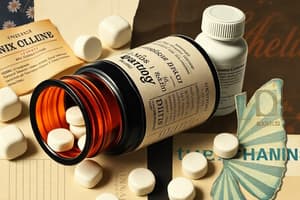Podcast
Questions and Answers
What is the primary purpose of the Basic Drug Knowledge list?
What is the primary purpose of the Basic Drug Knowledge list?
- To ensure students have a readily retrievable knowledge of outpatient and inpatient drugs. (correct)
- To ensure students have a comprehensive understanding of advanced pharmacology.
- To serve as a resource only for faculty members.
- To provide an exhaustive list of all medications.
Which of the following abbreviations indicates a route of administration that is NOT oral?
Which of the following abbreviations indicates a route of administration that is NOT oral?
- SQ (correct)
- IV (correct)
- PO
- IM (correct)
Which type of drug information is NOT included in the Basic Drug Knowledge list?
Which type of drug information is NOT included in the Basic Drug Knowledge list?
- Side effects and precautions.
- Antibiotic activity against common pathogens.
- Brand names for all drugs. (correct)
- Drug formulation and routes of administration.
How was the information in the Basic Drug Knowledge list verified?
How was the information in the Basic Drug Knowledge list verified?
What is indicated by the abbreviation 'CI' in the context of drug administration?
What is indicated by the abbreviation 'CI' in the context of drug administration?
Which side effect is associated with brimonidine (ophthalmic)?
Which side effect is associated with brimonidine (ophthalmic)?
What condition is timolol (ophthalmic) commonly used to treat?
What condition is timolol (ophthalmic) commonly used to treat?
Which of the following medications is a prostaglandin analog?
Which of the following medications is a prostaglandin analog?
What key side effect is associated with using chlorhexidine?
What key side effect is associated with using chlorhexidine?
For what condition is azelastine (intranasal) indicated?
For what condition is azelastine (intranasal) indicated?
Which medication is contraindicated with MAOI therapy?
Which medication is contraindicated with MAOI therapy?
What side effect is commonly associated with diphenhydramine?
What side effect is commonly associated with diphenhydramine?
Which of the following can cause ocular burning as a side effect?
Which of the following can cause ocular burning as a side effect?
What is the primary indication for permethrin?
What is the primary indication for permethrin?
What potential risk is associated with prolonged use of clobetasol?
What potential risk is associated with prolonged use of clobetasol?
What is a common side effect of corticosteroids like prednisolone?
What is a common side effect of corticosteroids like prednisolone?
What is an essential characteristic of pseudoephedrine?
What is an essential characteristic of pseudoephedrine?
Which medication is indicated for nail fungus treatment?
Which medication is indicated for nail fungus treatment?
Which of the following is a key side effect of fexofenadine?
Which of the following is a key side effect of fexofenadine?
Study Notes
Head, Ears, Eyes, Nose, and Throat Medications
- Alpha-2 agonist medications, such as brimonidine (brand name Alphagan P) and timolol (brand names Timoptic, Timoptic XE, Istalol), are used to treat elevated intraocular pressure (IOP).
- Prostaglandin analog medications, including bimatoprost (brand names Lumigan, Latisse), latanoprost (brand name Xalatan), and travoprost (brand name Travatan Z), are also used to treat elevated IOP.
- Calcineurin inhibitor medications like cyclosporine (brand name Restasis) are used to treat keratoconjunctivitis sicca, also known as dry eye.
- Corticosteroids, such as prednisolone (brand names Pred Forte, Pred Mild, Omnipred) are employed to manage ophthalmic inflammation.
- Pediculocide medications, like permethrin (brand names Nix, Elimite), are utilized to combat lice and scabies.
- Retinoic acid derivative medications like adapalene (brand name Differin) are used to treat acne.
- Antiseptic medications, such as chlorhexidine (brand names Hibiclens, Peridex), can be used topically or orally to cleanse the skin and manage periodontitis and gingivitis.
- Corticosteroid medications, like clobetasol (brand names Temovate, Clobex) and triamcinolone (brand name Kenalog), are used topically to treat conditions like psoriasis and atopic dermatitis.
Nasal and Sinus Medications
- Alpha (α1) agonist medications, specifically pseudoephedrine (brand name Sudafed), are used to relieve nasal congestion.
- Corticosteroids, such as fluticasone (brand name Flonase) and triamcinolone (brand name Nasacort), are effective in treating allergic rhinitis.
- Azelastine (brand name Astepro) is another intranasal medication used to alleviate allergic rhinitis.
- Histamine (H1) blocker medications like diphenhydramine (brand name Benadryl), hydroxyzine (brand names Atarax, Vistaril), cetirizine (brand name Zyrtec), loratadine (brand name Claritin), and fexofenadine (brand name Allegra) are often used in combination to treat allergic rhinitis, allergic reactions, and insomnia.
- Another histamine (H1) blocker used ophthalmically, olopatadine (brand names Pataday, Patanol) is employed to treat allergic conjunctivitis.
Cough and Cold
- Promethazine and codeine (brand name Phenergan with Codeine) is a combination of a histamine (H1) blocker and an opioid analgesic. It is used to relieve cough and cold symptoms.
- Important note: Concomitant use of opioids with benzodiazepines or other CNS depressants (including alcohol) can result in profound sedation, respiratory depression, coma, and death.
- Opioid-containing cough and cold products are no longer indicated for use in patients.
Studying That Suits You
Use AI to generate personalized quizzes and flashcards to suit your learning preferences.
Related Documents
Description
Explore the various medications used for the treatment of conditions affecting the head, ears, eyes, nose, and throat. This quiz covers alpha-2 agonists, prostaglandin analogs, calcineurin inhibitors, corticosteroids, and more. Test your knowledge on brand names and uses of these essential medications.




